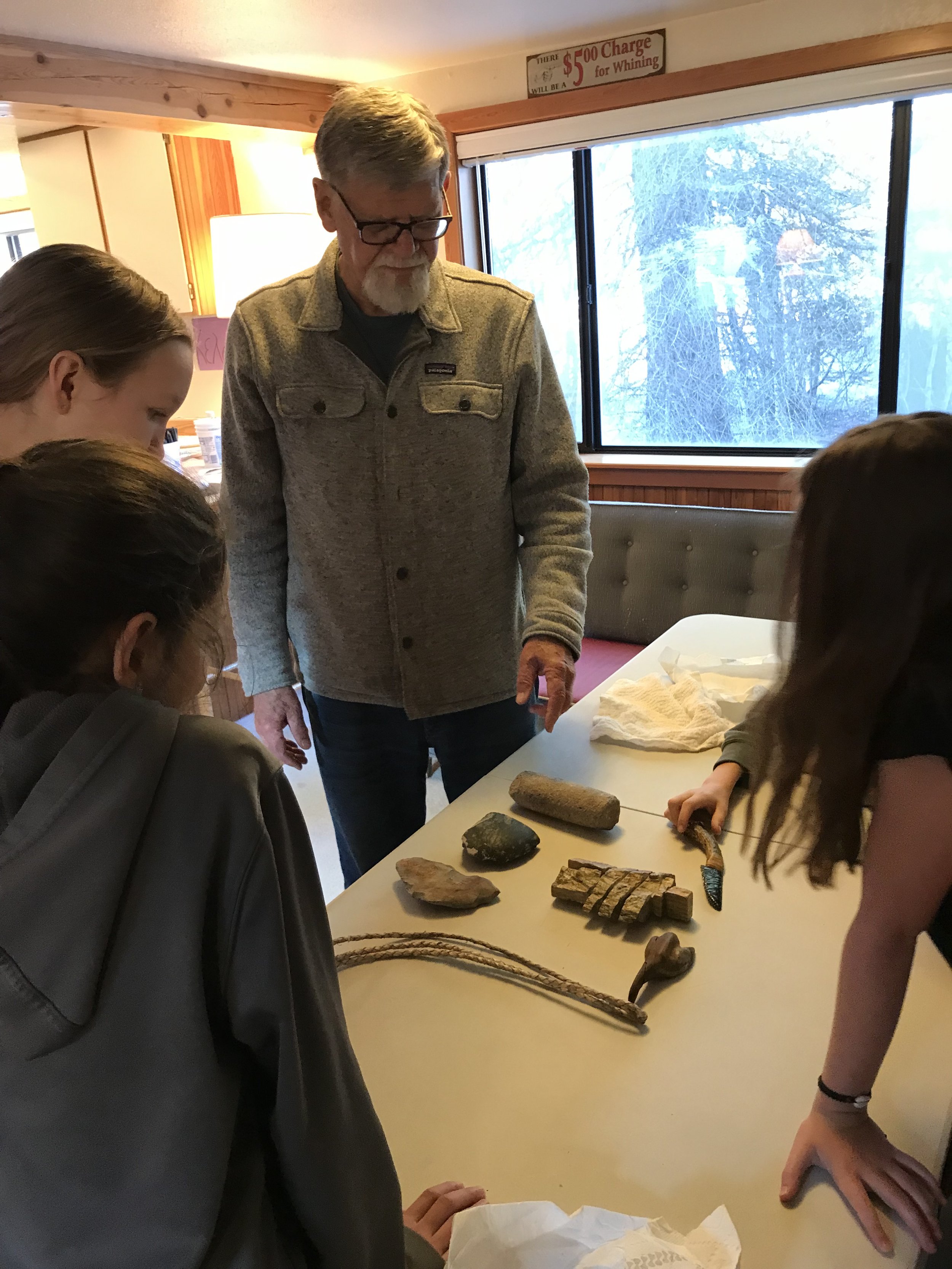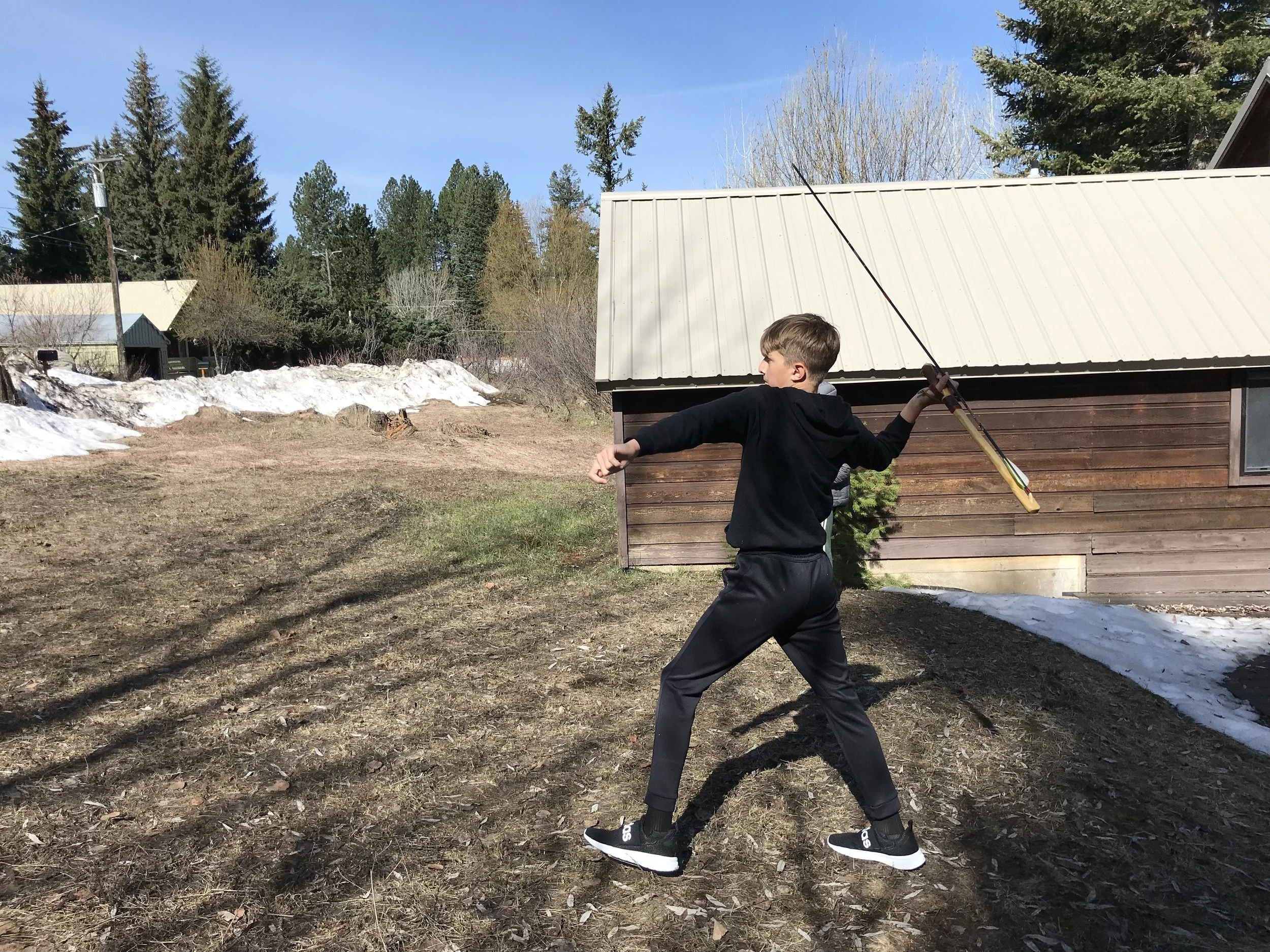Middle SCHOOL HUMANITIES
Ancient Cultures
Intro to American History
World History I
Revolutions
Visiting University of Idaho Professor Rich Howard explains archeological artifacts to NFS students
Spear-throwing techniques…
Humanities Foundations (3rd through 6th)
is a two-year introduction to North Fork's overarching integrated humanities curriculum, creating a solid foundation for budding scholars. Students begin to explore history and the role that geography, culture, governments, religion, and resources have on shaping civilizations.
Humanities Foundations is very hands-on, while also allowing students to strengthen reading comprehension and writing skills. Students practice asking meaningful questions, seek answers in various age-appropriate sources, role-play the parts of historic people, learn to express their ideas in thoughtful discussions, explore ancient practices through creative art projects (making clay cylinder seals, creating masks, crafting oil lamps, designing warrior shields, and more), play topic-based games, listen to ancient folktales and myths, and express their understanding and ideas through simple writing exercises.
Students also practice being thorough in their work and putting forth their best efforts. We will also practice taking simple unit tests together as a group to begin to build strong test-prep skills in a non-intimidating way. Humanities Foundations supports students along the path to becoming engaged scholars, driven by curiosity, and serves as a strong launch-pad into further North Fork School studies in middle and high school.
In Year 1, students explore the history and cultures of ancient Mesopotamia, Egypt, India, Greece, and Africa.
In Year 2, students explore ancient China, Rome, the European Middle Ages, the rise of Islam, and New World Empires of the Maya, Aztec, and Inca.
History 1: Ancient Cultures (6th & 7th) is designed for middle school students who have not previously completed the FULL two-year Humanities Foundations program. In Ancient Cultures, students proceed through a faster-paced exploration of history, with particular focus on the impacts of geography, resources, religion, government, and economies on the shaping of cultures.
While Ancient Cultures still provides some opportunities for hands-on creative projects, students' efforts in Ancient Cultures will be more focused on reading comprehension, forming and discussing ideas and hypotheses, understanding various points-of-view, developing a strong work ethic both individually and in groups, and developing strong communication skills — both written and conversational.
Class work involves reading and discussion, role-playing, timeline math, learning games, map work, identifying various types of reliable evidence, making charts and graphics, learning to take notes using Study Guides, and writing short essays.
Cultures covered will include those of ancient Mesopotamia, Egypt, Greece, India, China, Rome, Europe during the Middle Ages, Dar al Islam, Africa, and the New World Empires. In this course, students also begin to recognize how deeply history has shaped the present.
History 2: Intro to US History (7th & 8th) covers U.S. history from the period prior to European contact through the closing of the Western Frontier. This is a significant year for our history students, as we examine the roots of issues that continue to dominate contemporary debate and discourse. Through an exploration guided by our textbook and various primary and secondary source documents, historic voices will begin to sound not-so-far-distant from those around us as the story of our nation comes alive. The flow of our explorations will follow the calendar below (with some flexibility):
September: North America prior to contact, the Columbian Exchange, Spanish Conquest
October: Establishment of the First English colonies through the French & Indian War
November: The American Revolution
December through mid-January: Constructing the Constitution & Launching the Republic
mid-January through March: War of 1812 through the beginnings of Western Expansion
April and May: the Civil War, Reconstruction, and the Closing of the Western Frontier
Students work more closely with their textbooks and practice note-taking using unit study guides. They also practice becoming more responsible for managing their time, meeting deadlines, working independently and in small teams, contributing thoughtfully to discussions, being thorough in their work, and striving toward excellence.
In this course, students will also continue to learn through role-plays, games, and History Jeopardy contests. Interpretation of texts, identifying points-of-view, and understanding context become central to our history studies this year. Additionally, students complete their first short research paper, complete with citations, during third quarter. Political geography is introduced this year, as well, as students engage in map work alongside their history lessons, memorizing all 50 US states and their capitals by years' end. Students who take Introduction to US History as 8th graders can plan to take High School US History 2 as freshmen or sophomores and AP US History as juniors or seniors to meet their high school US history requirements.
History 2: Intro to US History (7th & 8th) covers U.S. history from the period prior to European contact through the closing of the Western Frontier. This is a significant year for our history students, as we examine the roots of issues that continue to dominate contemporary debate and discourse. Through an exploration guided by our textbook and various primary and secondary source documents, historic voices will begin to sound not-so-far-distant from those around us as the story of our nation comes alive. The flow of our explorations will follow the calendar below (with some flexibility):
September: North America prior to contact, the Columbian Exchange, Spanish Conquest
October: Establishment of the First English colonies through the French & Indian War
November: The American Revolution
December through mid-January: Constructing the Constitution & Launching the Republic
mid-January through March: War of 1812 through the beginnings of Western Expansion
April and May: the Civil War, Reconstruction, and the Closing of the Western Frontier
Students work more closely with their textbooks and practice note-taking using unit study guides. They also practice becoming more responsible for managing their time, meeting deadlines, working independently and in small teams, contributing thoughtfully to discussions, being thorough in their work, and striving toward excellence.
In this course, students will also continue to learn through role-plays, games, and History Jeopardy contests. Interpretation of texts, identifying points-of-view, and understanding context become central to our history studies this year. Additionally, students complete their first short research paper, complete with citations, during third quarter. Political geography is introduced this year, as well, as students engage in map work alongside their history lessons, memorizing all 50 US states and their capitals by years' end. Students who take Introduction to US History as 8th graders can plan to take High School US History 2 as freshmen or sophomores and AP US History as juniors or seniors to meet their high school US history requirements.
History 2.5: World History (7th & 8th) takes middle school students on a journey through world history from roughly 500 BCE through the Columbian Exchange. After a close look at US History the previous year, students now experience the exciting worldwide “prequel” to our national story. By zooming out for a broader view of world history, students will gain both a significant global perspective as well as a strong foundation for understanding the events that unfold in High school American history classes. We will end our school year exactly where we began the prior year, having spiraled up a level in our comprehension of history. The flow of our explorations will follow the calendar below (with some flexibility):
First Quarter (Sept-Oct): Early Asian Empires, the Classical World, Christianity, & North/South American civilizations
Second Quarter (Nov-Jan): Medieval Europe, the Byzantine Empire, Russia, & Islam
Third Quarter (Feb-March): African Kingdoms, Trade Networks, & East Asia
Fourth Quarter (April-May): Renaissance, Reformation, & Global Exploration
History 2.5 students practice finding the answers they seek in various texts, locating reliable online resources, making defensible claims supported by evidence, working independently and in small teams, sharing their ideas and questions in thoughtful discussions, and practicing debate skills through role-play exercises. Excellence in written work becomes increasingly central as students focus on expressing their understanding and ideas in highly organized short essays. As students explore primary and secondary source documents, they practice creating claims (translated into strong thesis sentences) that capture their understanding of the material. Students then move into the practice of collecting strong evidence to support their claims, and finally produce written work that expresses their arguments in an organized and elegant fashion. Students produce a longer (4-page) research paper this year, again with a complete citations page. History 2.5 students continue their geography studies throughout the year, focusing on world regions and culminating in a final geography exam in which they identify the locations of all currently-recognized nations.
History 3: Revolutions in History, (8th & 9th) explores “modern” world history (history after 1200 CE) through the lens of revolutionary events. We will begin where we left off at the end of History 2.5 with the Columbian Exchange and the cultural collision of the Eastern and Western hemispheres, then proceed through a variety of dramatic events that changed the world in BIG ways, including cultural, philosophical, economic, and military revolutions. Along the way, students encounter the Enlightenment, the birth of Western democracies, the African Diaspora, the Industrial Revolution, the first World War, and the Russian Revolution. Within these big events, we explore various individual stories and primary source documents to get a fuller picture of how daily life changed for diverse players in this sweeping historical drama. We’ll also explore the ways in which our lives today have been shaped by events of the past. The flow of our explorations will follow the calendar below (with some flexibility):
First Quarter (Sept-Oct): impacts of global exchange on North and South America, Europe, and Africa; the Enlightenment & American Revolution
Second Quarter (Nov-Jan): French Revolution & the Napoleonic Era, Industrial Revolution, Latin American Revolutions, and Romanticism
Third Quarter (Feb-March): Nationalism, Imperialism, Democracy, and Resistance around the world - what shapes values and identity?
Fourth Quarter (April-May): the World at War (WWI) and the Russian Revolution
History 3 students practice finding the answers they seek in various texts, locating reliable online resources, working independently and in small teams, sharing their ideas and questions in thoughtful discussions, and practicing debate skills through role play exercises. Excellence in written work continues to take center stage as students focus on expressing their understanding and ideas in highly organized essays. As students explore primary and secondary source documents, they practice creating claims (thesis sentences) that capture their understanding of the material. Students then practice collecting strong evidence to support their claims, and finally produce written work that expresses their arguments in organized and elegant fashion.
Students produce a 4-page research paper this year, again with a complete citations page. Additionally, History 3 students continue with geography studies with a year-long Geography Portfolio project focused on a contemporary nation of their choice. Through this process, students take an in-depth look at a country different from their own, expressing information about their chosen country in a variety of ways: each month will provide a new assignment, including work with maps, charts, advertising, graphs, statistics, images, and short essays. Students continue to spend significant time in class learning to make defensible claims supported by primary and secondary source evidence. This work will build and stretch critical thinking muscles, and the skills gained will be useful across disciplines and lay the groundwork for later AP-level work.






